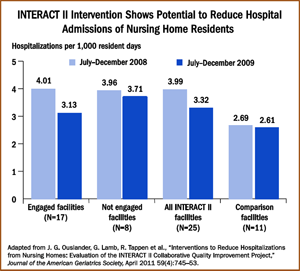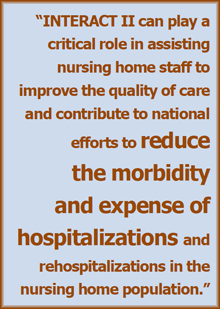Synopsis
An intervention designed to identify and manage acute conditions and status changes among nursing home residents resulted in a 17 percent reduction in hospital admissions.
The Issue
 Hospitalizations of frail nursing home residents can result in higher costs, complications, and death. Research suggests that a substantial proportion of these hospitalizations may be avoidable. In this Commonwealth Fund–supported study, researchers tested a program called Interventions to Reduce Acute Care Transfers (INTERACT) II that helps nursing home staff identify, assess, communicate, and document changes in residents' status. INTERACT II comprises three main tactics: identifying, assessing, and managing conditions to prevent them from becoming severe enough to require hospitalization; managing selected conditions, such as respiratory and urinary tract infections, in the nursing home itself; and improving advance care planning and developing palliative care plans as an alternative to acute hospitalization for residents at the end of life. The intervention was evaluated in 25 nursing homes over a six-month period.
Hospitalizations of frail nursing home residents can result in higher costs, complications, and death. Research suggests that a substantial proportion of these hospitalizations may be avoidable. In this Commonwealth Fund–supported study, researchers tested a program called Interventions to Reduce Acute Care Transfers (INTERACT) II that helps nursing home staff identify, assess, communicate, and document changes in residents' status. INTERACT II comprises three main tactics: identifying, assessing, and managing conditions to prevent them from becoming severe enough to require hospitalization; managing selected conditions, such as respiratory and urinary tract infections, in the nursing home itself; and improving advance care planning and developing palliative care plans as an alternative to acute hospitalization for residents at the end of life. The intervention was evaluated in 25 nursing homes over a six-month period.
Key Findings
- The 25 nursing homes that completed the program experienced a 17 percent reduction in hospitalization rates compared with the same six-month period in the previous year.
- Of the 25 nursing homes, 17 were characterized as "moderately or highly engaged" in the initiative. This group had a 24 percent reduction in hospitalizations, compared with a 6 percent reduction in the group of eight facilities rated as "minimally or not engaged" and a 3 percent reduction in a comparison group of 11 nursing homes.
- The average cost of the six-month intervention was $7,700 per nursing home.
- The authors estimate that the projected Medicare savings in a 100-bed nursing home could be about $125,000 per year.
 Addressing the Problem
Addressing the Problem
The effect of the intervention is substantial, say the authors. If implemented widely, the program could result in fewer complications, lower morbidity from hospitalizations, and reductions in Medicare costs. In the study, the reductions in hospitalization were achieved despite financial, legal, and regulatory incentives that favor hospitalization over the risks and costs of managing acute illnesses in the nursing home. The projected savings of $125,000 per year would be enough to support a full-time advance practice nurse or physician assistant in the nursing home, as well as the costs of implementing the intervention.
About the Study
INTERACT II was implemented at 25 community-based nursing homes in Florida, Massachusetts, and New York that were recruited for the project. Data on hospitalization rates were obtained from the nursing homes during the six-month implementation (July 2009–December 2009) and for the corresponding months in 2008. The INTERACT tools and resources are available at http://interact2.net.
The Bottom Line
The INTERACT II intervention has the potential to decrease hospital admissions among nursing home residents and reduce Medicare costs.


